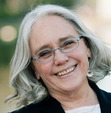Edith Maxwell's Blog, page 252
August 24, 2015
Feral cats need friends, too
By Liz, trying with all my might to hang onto summer.
 It’s August, which is Tuffy’s month to promote his story in Rescued: The Story of 12 Cat Through Their Eyes, in order to benefit his rescue of choice, the Friends of Feral Cheshire Cats (FFCC). So he wanted me to do a PSA of sorts about feral cats, in honor of his friend Lion, the feral he used to hang out with in his prior, outdoor life.
It’s August, which is Tuffy’s month to promote his story in Rescued: The Story of 12 Cat Through Their Eyes, in order to benefit his rescue of choice, the Friends of Feral Cheshire Cats (FFCC). So he wanted me to do a PSA of sorts about feral cats, in honor of his friend Lion, the feral he used to hang out with in his prior, outdoor life.

Lion hangs out on the roof of the shed back in the day.
Feral cats are often vilified by people who don’t understand their plight. While these cats are not socialized, they can still live happy, healthy lives outside. Many of them will even show their thanks to their feeders by coming close enough to pet every now and then.

Shaggy rocking her feral cat ears – note the ear tip!
Organizations like FFCC help by working with the community to humanely trap ferals, get them spayed or neutered and properly vaccinated, and arrange for an ongoing management plan to make sure they have food. Many of these groups also help by taking any feral kittens born outside and placing them in foster homes, where they can be socialized and placed in a home.
These groups are working with limited volunteers and resources, so they depend on the community to take ownership of colonies as they are able. If people pitch in, help trap and transport the cats to the vet and provide food, these colonies are managed well and the population doesn’t continue to expand.

Lori Ratchelous and Kerry Bartoletti of FFCC with me and Shaggy.
National Feral Cat Day, an annual awareness day sponsored by Alley Cat Allies, is happening Oct. 16 this year. People are encouraged to do something special for the ferals and register as an event. By doing so, they help the cats, help educate their communities and get some cool gear in the process.
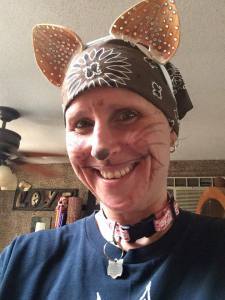
Kim as a feral cat.
We did an event with FFCC earlier this month in support of Rescued that was registered with National Feral Cat Day. We had a lot of fun talking to the community about what they can do to help, connecting with other feral cat supporters, and celebrating felines everywhere.
To find out more about feral cats, check out Alley Cat Allies. If you have a colony in your area that you’d like to help support, check out their page to find local resources that can help. And if you just want to help a local rescue, do that too. Tuffy and the ferals say thanks!
Readers, do any of you help with feral colonies?
Filed under: Liz's posts Tagged: Alley Cat Allies, feral cats, Rescued

August 21, 2015
Carolyn Mulford – Going to the Dog
Hi! Liz here, and today I’m welcoming the lovely Carolyn Mulford to the blog. Carolyn is another writer I’ve known from the beginning of my time in the mystery community, and I’m delighted to see this fabulous series getting such great attention. (You can read the first chapter of each of the books on her website.)Today she’s talking about one of my favorite topics: Dogs in books. Carolyn, take it away!
 I’m a planner. When I wrote Show Me the Murder (Five Star, 2013), I spent a lot of time developing three contrasting major characters: Phoenix, a wounded former CIA operative who returns to her Missouri hometown; Annalynn, a civic leader whose husband just died in a sleazy motel; and Connie, a struggling singer/music teacher.
I’m a planner. When I wrote Show Me the Murder (Five Star, 2013), I spent a lot of time developing three contrasting major characters: Phoenix, a wounded former CIA operative who returns to her Missouri hometown; Annalynn, a civic leader whose husband just died in a sleazy motel; and Connie, a struggling singer/music teacher.
I didn’t plan a fourth character, a Belgian Malinois called Achilles. He arrived on my screen as a plot point, the only witness to a crime. Phoenix finds him shot, starved, and tied to a tree. She identifies with him, saying, “Some of us don’t die so easily.” By the end of the book, she is his human for the series.
 Achilles poses some challenges to me as a writer. One is revealing his personality when he can’t talk and comes with no bio except being a DEA K-9 dropout. No big deal. He can’t tell, but he can show. For example, when Phoenix leaves him alone, he howls until she comes back. When she takes him into the backyard, he protects the hummingbirds from cats skulking at the feeders. When he meets Connie, he offers a paw for her to shake.
Achilles poses some challenges to me as a writer. One is revealing his personality when he can’t talk and comes with no bio except being a DEA K-9 dropout. No big deal. He can’t tell, but he can show. For example, when Phoenix leaves him alone, he howls until she comes back. When she takes him into the backyard, he protects the hummingbirds from cats skulking at the feeders. When he meets Connie, he offers a paw for her to shake.
In each book, he—like the other characters—reveals more of himself. In Show Me the Deadly Deer (Five Star, 2013), he refuses to get out of the car when rambunctious four-year-old twins want to play with him. Later, when the children face a tragedy, he allows them to maul him with affection. In Show Me the Gold (Five Star, 2014), he barks a reproof when Phoenix raises her voice to Annalynn. 
A persistent challenge is giving Achilles bits of action so readers knew what he’s doing. Is he sticking by Phoenix’s side, sniffing around, standing by the car to tell her he wants to go home?
Having Achilles as a major character also offers some unanticipated advantages. He exposes the softer side of the tough, cynical Phoenix. His nose and intelligence contribute to every investigation. In Show Me the Deadly Deer, he indicates that the murder didn’t take place where Phoenix found the body. In Show Me the Gold, he warns her of a booby trap. She soon learns to use him to disarm innocents, terrify bad guys, and back her up.
He also delights readers. At every book signing, someone says, “I love your dog.”
So do I.
Carolyn Mulford worked as the editor of national and international magazines and a freelancer before writing the award-winning Show Me mystery series. Harlequin Worldwide Mystery released a paperback edition of the first, Show Me the Murder, in June. Five Star will issue the fourth, Show Me the Ashes, in hardcover in December.
Carolyn, I can definitely relate to the dog-taking-over-as-a-character syndrome! Readers, what about you? Fave dogs or cats that make a series even better?
Filed under: Guest posts Tagged: Carolyn Mulford, dogs, Missouri, Show Me mystery series

August 20, 2015
Agatha Assumptions Upended
Many of you know that I am an unabashed Agatha Christie fan. I discovered her books when I was fourteen, the summer my family moved from Massachusetts to Maryland. It was a miserable time for me, but I got lost in the world of Miss Marple, and stayed there all summer. Hercule Poirot and I met a little later. Still later I read her short stories, and her stand alones. And, of course, Tommy and Tuppence.
 The picture on the right is how most of us know her–older, writerly, sitting at a desk. She was very shy, and did not love the public eye. This past Sunday I read an article about a new exhibition of photos of her. They upend the expectations that have been cultivated. She wasn’t always an old woman. We know that, of course, but evidence is always good to have. More importantly, as importantly, she lived a life. She surfed, she traveled, she had her heart broken by her first husband, met her second husband and followed him on his archaeological adventures. I love this photographic evidence. What great adventures!
The picture on the right is how most of us know her–older, writerly, sitting at a desk. She was very shy, and did not love the public eye. This past Sunday I read an article about a new exhibition of photos of her. They upend the expectations that have been cultivated. She wasn’t always an old woman. We know that, of course, but evidence is always good to have. More importantly, as importantly, she lived a life. She surfed, she traveled, she had her heart broken by her first husband, met her second husband and followed him on his archaeological adventures. I love this photographic evidence. What great adventures!
Agatha Christie’s work continues to impact my life. When I went to the Harvard Extension School, and was working on my thesis topic, I decided to write about her, and her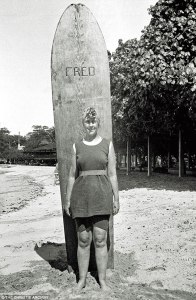 use of point of view. I focused on the novels she
use of point of view. I focused on the novels she wrote from 1920, when she started to write, to 1940. Though she wrote some fine novels after that period, those twenty years included And Then There Were None, Murder on the Orient Express, and The Murder of Roger Ackroyd. I dream of writing a book to equal any one of these three. She wrote 75 other novels as well as over 100 short stories, and 19 plays.
wrote from 1920, when she started to write, to 1940. Though she wrote some fine novels after that period, those twenty years included And Then There Were None, Murder on the Orient Express, and The Murder of Roger Ackroyd. I dream of writing a book to equal any one of these three. She wrote 75 other novels as well as over 100 short stories, and 19 plays.
As a writer, her craft provides a lot of lessons. Her characters were broad, and played into stereotypes of her age. That said, the way she draws her characters allows readers to identify with them easily, even today. Her plots are clever, and play a good game with the reader. Her narrative style, including use of point of view, is expert.
Last year I wrote a post about the “Lessons from Dame Agatha”. A year later, close to her 125th birthday (next month!) I can still learn more about her, and be surprised by her life. She continues to inspire me.
Maybe I should try and surf?
Filed under: Julie's posts Tagged: agatha christie

August 19, 2015
Wicked Wednesday – Inspiration
It’s Wicked Wednesday, when we all weigh in on a topic.
Some days, we all need inspiration. A lot of us need it EVERY day…so today we’re doing a round up of the best inspirational quotes you know. Or the best inspirational people in general — we’re not picky. We’ll take it where we can get it! And maybe we’ll create a giant inspirational board out of all of these, if enough readers leave their favorite. So let’s get to it!
Wickeds, tell us what quote or person most inspires you?
Jessie: “Be yourself; everyone else is already taken.” Oscar Wilde

5.0.2
Liz: “It’s a very funny thing about life; if you refuse to accept anything but the best, you very often get it.” W. Somerset Maugham
Edith: “Carpe Diem. Seize the day, boys. Make your lives extraordinary.” Character John Keating, played by Robin Williams, in Dead Poets Society.
 Sherry: This relates to writing and sits on my desk: “Don’t tell me the moon is shining, show me the glint of light on broken glass.” Anton Chekhov
Sherry: This relates to writing and sits on my desk: “Don’t tell me the moon is shining, show me the glint of light on broken glass.” Anton Chekhov
Barb: “It is never too late to be what you might have been.” George Eliot (attributed)
Julie: “You gain strength, courage and confidence by every experience in which you really stop to look fear in the face. You are able to say to yourself, ‘I have lived through this horror. I can take the next thing that comes along.’ You must do the thing you think you cannot do.” Eleanor Roosevelt
Readers, tell us yours!
Filed under: Wicked Wednesday Tagged: Anton Chekhov, George Eliot, Oscar Wilde

August 18, 2015
Beginnings
Sherry in northern Virginia where summer isn’t over yet, thankfully (but I wouldn’t mind if the humidity turned down a notch or two!)
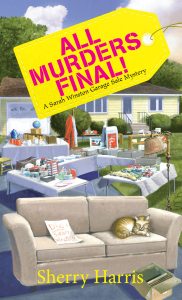 I’ve thought a lot about beginnings over the summer. I turned in All Murders Final, the third in the Sarah Winston Garage Sale series, on June 3rd. Shortly after that I turned a proposal in for more books. And then I waited. It gave me time to think about what I would do if the series wasn’t renewed. What would I work on? Start something new or revisit my unsold series that is set in Seattle and features a gemologist? My agent and I tossed around ideas for a new series but haven’t hit on something we both believed in.
I’ve thought a lot about beginnings over the summer. I turned in All Murders Final, the third in the Sarah Winston Garage Sale series, on June 3rd. Shortly after that I turned a proposal in for more books. And then I waited. It gave me time to think about what I would do if the series wasn’t renewed. What would I work on? Start something new or revisit my unsold series that is set in Seattle and features a gemologist? My agent and I tossed around ideas for a new series but haven’t hit on something we both believed in.
Last Thursday morning at 5:15 the beginning of book four woke me up. I didn’t know whether to start writing or put the thoughts aside. Around ten that morning I emailed a few friends to see if they could have lunch on Friday. About fifteen minutes after I sent the email my agent called saying Kensington wanted two more Sarah books. Lunch the next day turned into a celebration.
Lots of writers celebrate writing The End. But I like to celebrate The Beginning. I cleaned my office over the weekend. This morning I opened a new computer file titled Buy Another Day — the working title. There is something so thrilling about starting, endless possibilities, surprises waiting to happen, and hard work. Hard Work!
I recently talked about the opening of Tagged for Death on Debra H. Goldstein’s blog, It’s Not Always a Mystery. You can read it here: https://debrahgoldstein.wordpress.com/2015/08/03/guest-blogger-sherry-harris-openings/
I searched the Wicked Cozy blog to see what we’d written about beginnings and found this excellent post by John Dufresne. It was an excellent time to rediscover it. I love this line: Don’t begin with an idea. Ideas are abstract; fiction exists in images, like dreams. (If you ever get the chance to take one of his classes do it — he’s amazing.)
 After an early morning walk, I opened a new file and wrote the first lines:
After an early morning walk, I opened a new file and wrote the first lines:
“You’re going to sell my Pyrex for so little? You might as well give it away.” Not only did Mrs. Spencer’s voice shake but her whole body did too. She snatched the Pyrex dish out of my hand and thrust it at the startled woman standing in front of me.
It starts with conflict and an image. I’m not sure these lines will stay the first lines, or it will stay a piece of Pyrex, or Mrs. Spencer’s name will stay the same. But it’s a beginning.
Readers: I asked this question over on Debra’s blog — do you have a book with a favorite beginning?
Filed under: Sherry's posts Tagged: All Murders Final, Beginnings, Buy Another Day, Debra Goldstein, It's Not Always A Mystery, John Dufresne, Kensington Publishing, Sarah Winston Garage Sale Mysteries

August 17, 2015
Guest: Nancy Herriman
Edith here, soaking up late-summer heat.
I’m excited to welcome fellow historical mystery author Nancy Herriman to the blog today  with her new “A Mystery of Old San Francisco” series. This series sounds especially appealing to me as I am a native Californian, and it’s set only twenty years before my own historical series. Nancy’s first book in the series is No Comfort for the Lost. What a great title! I confess I haven’t had a chance to read it yet, but it’s next up on my Kindle. So take it away, Nancy.
with her new “A Mystery of Old San Francisco” series. This series sounds especially appealing to me as I am a native Californian, and it’s set only twenty years before my own historical series. Nancy’s first book in the series is No Comfort for the Lost. What a great title! I confess I haven’t had a chance to read it yet, but it’s next up on my Kindle. So take it away, Nancy.
Setting a Mystery in 1860s San Francisco
First off, thanks for hosting me! I thought I’d talk about why I chose 1860s San Francisco as a setting for my new mystery series. I’ve always found the city fascinating, and I think most people are familiar with its lore—stories about the 49ers and the Gold Rush, the Chinese laborers working on the Pacific Railroad, the famous people who lived there at that time, such as Mark Twain, Levi Strauss, J.A. Folger of coffee fame, Leland Stanford, Ghirardelli. There was so much going on, so much to see. Even then, it was an insanely popular tourist destination—I wonder if it was as hard to find a parking spot near the shoreline as it is now—and a huge draw for folks looking for a fresh start in life.
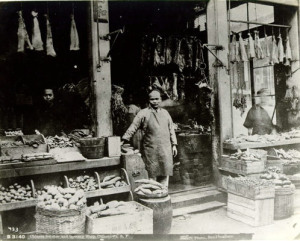 In the 1860s, San Francisco was one of the most diverse cities in the country, if not the most diverse. I decided to make use of that diversity and feature various immigrants in my book—my English heroine, the Irish scamp she’s taken under her wing, the boisterous Italian family living next door, her bossy Scottish housekeeper, all the Chinese she interacts with, including her half-Chinese cousin. A rich melting pot of people with an equally rich supply of problems.
In the 1860s, San Francisco was one of the most diverse cities in the country, if not the most diverse. I decided to make use of that diversity and feature various immigrants in my book—my English heroine, the Irish scamp she’s taken under her wing, the boisterous Italian family living next door, her bossy Scottish housekeeper, all the Chinese she interacts with, including her half-Chinese cousin. A rich melting pot of people with an equally rich supply of problems.
And of course, the city is also infamous for being rough-and-tumble, its Barbary Coast (not  actually on the coast, but named after the notorious Berber coastal region of North Africa) well-known for vice. Saloons, opium dens, and illegal gambling parlors existed to serve the male—and sometimes female—inhabitants. There were over 1000 drinking establishments in the city, nearly 1 for every 12 residents. You wouldn’t have any trouble finding a seat in a bar, I suppose!
actually on the coast, but named after the notorious Berber coastal region of North Africa) well-known for vice. Saloons, opium dens, and illegal gambling parlors existed to serve the male—and sometimes female—inhabitants. There were over 1000 drinking establishments in the city, nearly 1 for every 12 residents. You wouldn’t have any trouble finding a seat in a bar, I suppose!
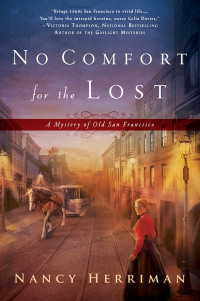 And where there are vices, there are crimes. My heroine in No Comfort for the Lost, Celia Davies, is a strong-willed British nurse who runs a clinic for poor women. She becomes involved in crime-solving when one of her Chinese patients is found dead in the bay. Being who she is, Celia most certainly wants to help find the girl’s killer. Even if the handsome detective assigned to the case has other ideas about her involvement.
And where there are vices, there are crimes. My heroine in No Comfort for the Lost, Celia Davies, is a strong-willed British nurse who runs a clinic for poor women. She becomes involved in crime-solving when one of her Chinese patients is found dead in the bay. Being who she is, Celia most certainly wants to help find the girl’s killer. Even if the handsome detective assigned to the case has other ideas about her involvement.
Readers: What are your favorite settings for historical mysteries? Is there a setting and era you wish someone would set a mystery in? What about your own memories of visiting San Francisco? Ask Nancy a question today – she’ll be stopping in to respond.
Nancy Herriman retired from an engineering career to take up the pen. She hasn’t looked back. Her work has won the RWA Daphne du Maurier award, and No Comfort for the Lost (NAL) was chosen as the Library Journal August 2015 Pick of the Month. When not writing, she enjoys singing, gabbing about writing, and eating dark chocolate. She currently lives in Central Ohio with her family. Learn more at: www.nancyherriman.com
Filed under: Guest posts Tagged: historical mystery, NAL, Nancy Herriman, No Comfort for the Lost, San Francisco

August 14, 2015
Mystery, friendship, persistence, and lots of laughs at Windsor Locks Public Library
Liz here, and today I’m excited to welcome a very special guest – Eileen Pearce, librarian at Windsor Locks Public Library here in Connecticut. I first met Eileen last year when she invited Edith and me to do an event at the library. You never know how library events are going to go, but we were thrilled – the crowd was plentiful, the interest and enthusiasm were high, and we had such fun! The library has an active mystery book club that really welcomes authors. This past summer, Barb joined me and Edith for a second event, and as long as Eileen will have us, we plan on returning as often as possible! I invited Eileen to tell us about the group, the Christie Capers Book Club. All yours, Eileen!
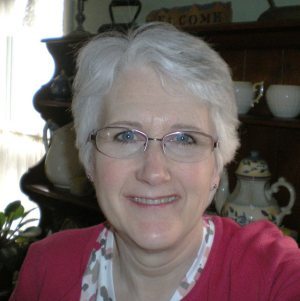 Many of you haven’t heard of the town that I have called home for 30 years. Windsor Locks, CT is 9.2 square miles and has a population of 12,500. We are the home of Bradley International Airport, which most people think is in Hartford. Our Little League team won the World Championship in 1965 and Ella Tambussi Grasso, governor of Connecticut from 1975-1980 (and the first woman in the United States elected governor in her own right) was born here in 1919. Oh, and our latest claim to fame is that one of the finalists on this year’s version of The Bachelorette is from Windsor Locks!
Many of you haven’t heard of the town that I have called home for 30 years. Windsor Locks, CT is 9.2 square miles and has a population of 12,500. We are the home of Bradley International Airport, which most people think is in Hartford. Our Little League team won the World Championship in 1965 and Ella Tambussi Grasso, governor of Connecticut from 1975-1980 (and the first woman in the United States elected governor in her own right) was born here in 1919. Oh, and our latest claim to fame is that one of the finalists on this year’s version of The Bachelorette is from Windsor Locks!
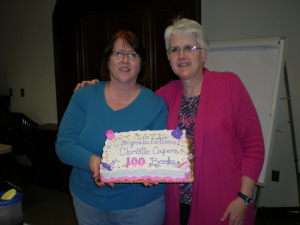
Christie Capers co-founders Janet Lomba and Eileen
I like to think that the Windsor Locks Public Library’s Christie Capers Book Club is another distinctive selling point of our small town. My good friend Janet, a library volunteer, and I, the Adult Services Librarian, started the group in 2002. We appropriated the name, Christie Capers, from one of author Carolyn G. Hart’s Death on Demand mysteries, and she was gracious enough to offer a signed copy of one of her novels as a door prize for our first meeting in September 2002. Our first book was, appropriately, Agatha Christie’s The Body in the Library. Our plan was to read and discuss “traditional” mysteries, which feature a murder, the gathering of clues by a professional or amateur sleuth, and the solution to the crime. We were thrilled to have a dozen people attend that first meeting, but quickly lost some of our enthusiasm when only a few showed up for our second. Traditional mysteries, especially cozies, can be difficult to discuss since they all follow a basic formula and don’t usually have intense psychological plotlines or a lot of complex characters. A couple of our members kept pushing for thrillers over the first few years that we met, so we did read some Harlan Coben and Patricia Cornwell during those early years, but our hearts really weren’t in it. Now we read only traditional mysteries, some cozy and some more “noir,” choosing a different theme each year. Fortunately there are SO many great mysteries around that that we never want for ideas! We’ve read female sleuths, professional vs. amateur sleuths, mysteries set in different countries, mysteries featuring real people as detectives, and craft-based mysteries, to name a few of our themes. During this past year we’ve been reading novels featuring religious sleuths and our upcoming theme is mysteries featuring a strong sense of place, novels in which the setting is key to the series, like those of Colin Cotterrill, Louise Penny, and Charles Finch. I’m thinking that it is definitely getting to be time to focus on some culinary series soon!

Christie Capers Tea
We spent about a decade as a pretty small group, but over the past few years interest in discussing mysteries has apparently exploded here in north central Connecticut! We now have about 25 members, many from surrounding towns and several from Massachusetts. We have hosted many wonderful authors, enjoying fascinating discussions with three of the Wicked Cozies, Edith Maxwell, Liz Mugavero, and Barbara Ross. Laura Bradford (aka Elizabeth Lynn Casey), author of an Amish mystery series and the Southern Sewing Circle Mysteries, has visited 5 times and essentially become our library’s mystery mascot. Sandra Parshall, a wonderful writer based in the D.C. area, donated a whole box of Under the Dog Star, one of her Rachel Goddard mysteries, to our delighted group, all big fans of hers. Anne Canadeo, author of the Black Sheep Knitting Mysteries has stopped in to see us twice, and we were thrilled to be one of the first libraries to introduce Susannah Hardy, author of the Greek to Me Mysteries, to the world. We look forward to meeting Roberta Isleib (Lucy Burdette) in August.
Reading and discussing mysteries are always great pastimes and meeting our favorite (and future favorite) authors is a thrill, but the most wonderful things about a book club, even one as big as ours, are the friendship and the laughter. Every month different combinations of members meet. Diane is our chocolate martini expert, always a hit at our annual Christmas pot-luck meeting. Karen, originally from Fall River (or “Fall Rivah”, as she says), and Shirley, from England, add a bit of an exotic flair to our meetings with their accents. Geri is our deadpan comedienne (“they grilled him like a cheeseburger”) and Terry is an expert at faux-cluelessness. Janet’s explosive laughter, Mary P’s sweet girlish voice, Nancy’s travel anecdotes…all of these contribute to a wonderful sense of comraderie. We have sympathized with each other’s losses, worried about illnesses, and expressed joy at marriages, children’s graduations, and new jobs. There might be 12 of us or there might be 24 at a meeting. When someone doesn’t show up and we haven’t heard from them, we worry about them. When others, whose active lives, jobs, and varied interests sometimes prevent them from attending, DO show up, we let them know how much we missed them. Sometimes we love the book and clamor to read more of the series, while at other times Janet and I get the stink-eye for choosing a book that is not to everyone’s taste. But no matter how we feel about our book, the library’s community room is always filled happy voices and the frequent sound of laughter on the third Wednesday of every month. This is Christie Capers, still going strong after 13 years, 122 books, 15 author visits, and many, many holiday chocolate martinis.
Filed under: Guest posts Tagged: agatha christie, authors, Christie Capers Book Club, cozy mysteries, Elizabeth Lynn Casey, Laura Bradford, lucy burdette, sandra parshall, traditional mysteries, Windsor Locks Public Library

August 13, 2015
Comfort
Jessie: Serving time in book jail on the coast of Maine
You know those times when you start to think about your health? Your allergies never seem to stop flaring? Your energy is flagging? A friend receives a shattering diagnosis? Lately, Ive been thinking a lot about all of those things. Unfortunately, becoming healthier isn’t something I can subcontract. So, for the past couple months I’ve been making some hard choices and cutting out things from my diet I suspect aren’t in my best interest.
I feel like it’s been, on balance, a good decision but there are things that I miss. Especially now that my deadline is looming and the craving for comfort food is like a gong in my head. I’ve managed to muffle it with walks on the beach and glasses of water but every now and again I’m plagued by the desire for freshly baked bread. Or a cheese plate. Champagne bubbles. A reuben heaping with sauerkraut. Buttered popcorn.
Lately, I’ve come up with another sort of solution. I’ve been giving my characters meals filled with all those things I’ve been avoiding. Glasses of milk, slices of cake. Fudge and taffy. The strange thing is how much vicarious pleasure I am taking in their meals. It’s the perfect solution. As I imagine and describe the treats I am giving them I feel like I ate them myself. After a good morning at the desk I’m happy with a salad for lunch. Sweet potatoes taste as good a fries from the Pier when I’ve spent the afternoon allowing my protagonist to have her fill.
Will it always work? Probably not. But for now, I’ll take comfort food any way I can get it.
Readers, do you have any comfort foods you turn to during times of stress? Writers, do your characters eat more or less healthily than you do?
Filed under: Jessie's posts Tagged: diet, food

August 12, 2015
Wicked Wednesday – Favorite Library Memories
It’s Wicked Wednesday, when we all weigh in on a topic. And today, we’re celebrating libraries. In the course of our work, we’ve all been lucky enough to appear in libraries, meet librarians and readers who found our work through their local libraries. It’s a blessing to have those opportunities. But memorable library experiences happened way before we were all published authors. So Wickeds, what’s your favorite library memory?
Edith: I spent so much time in the Temple City Public Library as a child. It’s situat ed at the edge of the town park, so lots of playing went on there, too (remember when slides were made of metal and got really hot in the summer?). I used to sign up for the summer reading program, and had to draw a picture and write a short book report for each book I read. I always wanted to get more gold stickers than anybody else, and managed to do so a couple of years in a row.
ed at the edge of the town park, so lots of playing went on there, too (remember when slides were made of metal and got really hot in the summer?). I used to sign up for the summer reading program, and had to draw a picture and write a short book report for each book I read. I always wanted to get more gold stickers than anybody else, and managed to do so a couple of years in a row.
 Barb: The summer between fourth and fifth grade, my family moved from Montclair, New Jersey to Wallingford, Pennsylvania. I had spent my first five school years at a single elementary school in Montclair, and the move to another state left me feeling disoriented and dislocated. The saving grace was that the Helen Kate Furness Library was in our little sidewalk-less development of Heatherwold and I could go there any time I wanted. The Helen Kate Furness is definitely the library that formed me as a reader. I’ve written more extensively about the library here. My favorite memory is of the time the children’s librarian drew me aside and gently suggested that I get my books upstairs. I climbed the stairs to the adult collection and never looked back.
Barb: The summer between fourth and fifth grade, my family moved from Montclair, New Jersey to Wallingford, Pennsylvania. I had spent my first five school years at a single elementary school in Montclair, and the move to another state left me feeling disoriented and dislocated. The saving grace was that the Helen Kate Furness Library was in our little sidewalk-less development of Heatherwold and I could go there any time I wanted. The Helen Kate Furness is definitely the library that formed me as a reader. I’ve written more extensively about the library here. My favorite memory is of the time the children’s librarian drew me aside and gently suggested that I get my books upstairs. I climbed the stairs to the adult collection and never looked back.
Liz: When I was little, my mother used to take me to the Stevens Memorial Library in North Andover, MA. My dad owned a business nearby, and during the summer it was a weekly tradition to stop by a couple times each week, which always coincided with visits to the library. It was here that I found the novel Daphne’s Book, my first young adult book aside from the Nancy Drew series. I loved this book, and even though I’d already read it (many times) I used to take it off the shelf and re-read my favorite parts every time I visited the library.
Jessie: I cannot possibly choose just one. Twenty years ago my husband and I bought our first home in part because it was next door to the library. My children’s lives and my own have been entangled and enriched by that space ever since. From story time to garden club meetings to discovering the works of E.F.Benson there has been so much joy. If pressed I would say standing in that building, surrounded by family and friends for the launch of my first book was probably my favorite memory.
 Sherry: I was lucky to grow up in Davenport, Iowa a small city with a fantastic library system which I just read was the largest Carnegie library west of the Mississippi. I loved trips to the main library downtown with its towering shelves of books but once a week the bookmobile visited a nearby park and there was rarely a week that we didn’t go. In high school we went to the library downtown to “study” aka flirt. I looked up the history of the Davenport Public Library and the new library built in the sixties was designed by Edward Durrell Stone who designed the Kennedy Center here in DC. The history of the Davenport Public Library is interesting (women’s right to vote helped) and you can read about it here.
Sherry: I was lucky to grow up in Davenport, Iowa a small city with a fantastic library system which I just read was the largest Carnegie library west of the Mississippi. I loved trips to the main library downtown with its towering shelves of books but once a week the bookmobile visited a nearby park and there was rarely a week that we didn’t go. In high school we went to the library downtown to “study” aka flirt. I looked up the history of the Davenport Public Library and the new library built in the sixties was designed by Edward Durrell Stone who designed the Kennedy Center here in DC. The history of the Davenport Public Library is interesting (women’s right to vote helped) and you can read about it here.
Julie: I lived in Duxbury, MA 1st through 8th grade. The town library (which is now an arts center) was my favorite place in the world. My mother is a voracious reader, and went to the library at least once a week. I’d go with her, and get lost in the stacks. I vaguely remember what it looked like, but I do remember the feeling I had there. Bliss.
Readers, what’s your favorite library memory?
Filed under: Wicked Wednesday Tagged: Carnegie, Davenport Public Library, e.f. benson, Edward Durrell Stone, Helen Kate Furness Library, North Andover MA, Stevens Memorial Library, Temple City Public Library, Wallingford PA

August 11, 2015
Mythbusting–Cozies Are Not The Shallow End Of The Fiction Pool
Susannah here, enjoying a cup of joe … and avoiding housework .. .
So, my Wicked people, today I thought we’d have a Mythbusting session. No, I’m not going to use a magnifying glass and the sun to start a campfire, or investigate the potentially uncomfortable results of combining Pop Rocks and soda. Not that that wouldn’t be fun–er, educational!
I belong to a number of different writers’ email loops, and they are sources of invaluable information. But sometimes they are full of misinformation. Or perhaps I should say misperceptions.
Recently on one of the loops someone mentioned the “fact” that cozies are not “deep” and that she was having trouble connecting with her characters and story. This was her first cozy contract, but she had extensive experience writing in the romance and paranormal genres. A couple of people chimed in that they were writing or reading cozies and either implied or came right out and said that cozies were “light,” the implication being that they were shallow.
I’m going on the record right now to tell you that traditional, cozy mysteries do NOT have to be shallow, devoid of character arcs and development, or plot driven to the point that the characters don’t matter. Certainly no Wicked Cozy or Accomplice is writing books like that! I butted in and emailed the author privately and we brainstormed some ways that she could not only get more into her sleuth’s head, but tie what’s in her head to the plot–both the immediate plot (the murder), and the ongoing plot (the character’s backstory and development over the series). So in case this helps any writer or reader get a better handle on adding or identifying depth in stories–any genre–here are some of the thoughts and techniques I offered:
The key difference between an ongoing series, like a cozy mystery or darker procedural, and a standalone, like a romance, is that the main character’s entire character arc cannot–in fact, MUST not–be revealed in one book. In a romance, you only get one chance. There are two main characters, and they fall in love, overcome obstacles to their relationship, including both external AND internal, and in the end they get together with a promise of a Happily Ever After. The End. These characters may make cameo appearances in later related novels, but their character arcs are essentially completed because subsequent books have new romantic partners as main characters.
However, in an ongoing series, if the author reveals everything in the first book, or starts the main character from a place where she’s already settled (already happily married, already has children, already firmly established in a profession, completely secure in her place in the community), the author and the story have nowhere to go in subsequent books. An exception to the above would be if the character starts from a place where she THINKS she’s settled or all her demons are conquered, but then something happens to throw that balance way, way off.
Give the main character some family issues. A mother or father who abandoned her. A sibling with whom she has never gotten along. An interfering grandmother. An awful ex-husband with a new trophy wife. A mother or father who disapproves of what she is doing with her life. A family secret that no one ever talked about, but that suddenly comes to a head, causing strong emotions to come up. This ensures lots of plot and conflict material for future books. And if a relative or someone else from her past gets killed off later, the heroine will have to deal with the guilt that they never reconciled. Or maybe one of these people is accused of murder, and the heroine finds she can use finding the real killer as a means of reconciliation. Does the heroine take some action, thinking she’s doing the right thing, but in the process injures an innocent person and must find a way to deal with her guilt and make things right?
Give your heroine a deep-seated reason to want/need to succeed. She could have a need to prove her parents wrong–they wanted her to go to law school, but she wanted to open a bead store and make jewelry. Or she could have had a boss or a teacher who told her she had no talent and would never amount to anything, and she has believed it, limiting her success. Or maybe she grew up on the wrong side of the tracks, so it’s vitally important to her to have roots and financial security. Or maybe she has been working at a job that sucks the life out of her but pays the bills, but her real dream is to drive an ice cream truck. Does she have a physical challenge that she has always been told will prevent her from being what she wants to be, and she needs to change her belief system in order to get there? Help the character find a way or ways over time to move closer to her dream(s).
Use secondary characters as foils for the sleuth’s over-time development. Example: a friend falls for a con man, and the heroine knows he’s dishonest because the guy tells the same kind of stories as her own ex. So helping her friend also gives her some closure with her own issues. Or a member of the community or the sleuth’s mentor figure used to be a stockbroker, but gave it all up to come home to her small town to open her dream knitting shop. By example, the heroine sees that living authentically is possible, which could allow her to grow and develop and make strides toward her dream(s).
This cozy stuff is like any other genre fiction–it just happens at a slower rate over a series. The thing is that whatever character issues you choose, they have to be woven in over the framework of the mystery itself. So the character issues should tie in with the heroine’s success–or failure–at solving the mysteries.
It’s your turn, readers and writers. How much character development do you want to see, and how quickly do you want it to happen over a series? What are some examples of series that make character development a priority (whether or not you agree with the direction the author chose to take her/his character, which is another topic entirely)?
Filed under: Craft, Jane's posts, Uncategorized, Writing Tips Tagged: character arc, character development, cozy mysteries, mystery series, Mythbusters, secondary characters


